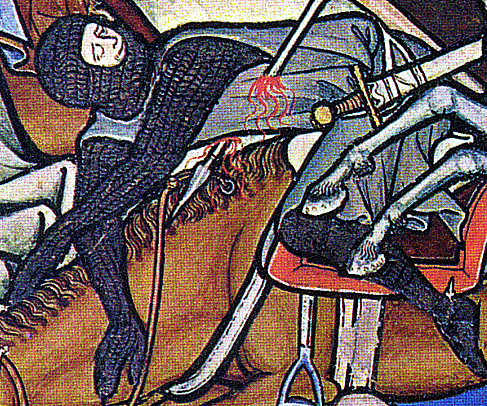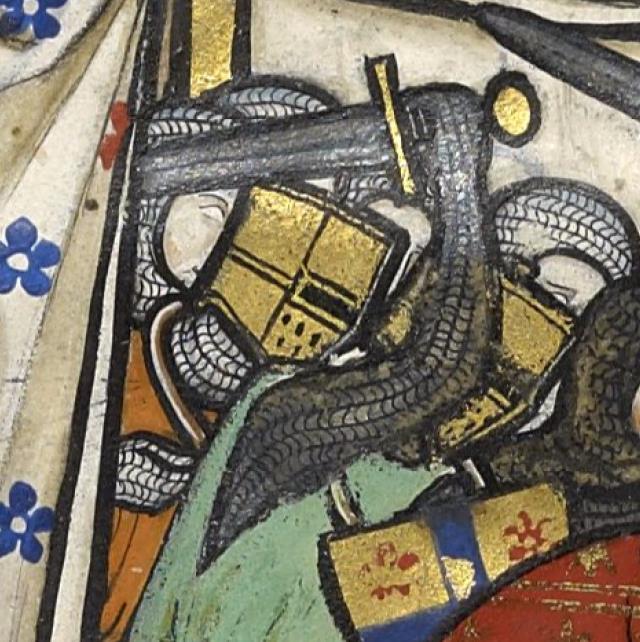| Author |
Message |
Eric S

|
 Posted: Fri 25 Dec, 2015 9:42 am Post subject: European riveted mail hauberk found in Japan. Posted: Fri 25 Dec, 2015 9:42 am Post subject: European riveted mail hauberk found in Japan. |
 |
|
If any European/foreign armor that was brought to Japan and used by the Japanese is called a Namban (Southern barbarian) armor then this European riveted mail hauberk is a namban kusari katabira (foreign mail jacket). The Japanese owner assumed that is was Japanese riveted mail, which is understandable since most Japanese collectors have not seen Japanese riveted mail, and almost certainly have not seen any European riveted mail. It was obvious to me that instead of being Japanese riveted mail it was European wedge riveted mail and by the style it appeared to be very old.
This armor is quite heavy, around 20lbs, all wedge riveted mail, with long sleeves, v neck and a collar made with thicker, dense mail with solid links on the top edge, the front is slightly longer than the back. It has been black lacquered in the Japanese style, and there are two purposely made holes in front and one in back, I am assuming the front holes are for a belt and the back hole for a scabbard worn tachi stype to pass through, as when riding a horse. To me it looks like a 15th century German hauberk, and it is the only example I have ever seen of European mail being used in Japan.
The first image is a comparison with a known 15th century German hauberk.







|
|
   |
 |
|
Mart Shearer
|
 Posted: Fri 25 Dec, 2015 11:48 am Post subject: Posted: Fri 25 Dec, 2015 11:48 am Post subject: |
 |
|
Cool. At least you found documentation for blackened European mail (when used in Japan). The Portuguese first visited in 1543, so I wonder if this wasn't a good way to get rid of old armor for profit in the following decades.
ferrum ferro acuitur et homo exacuit faciem amici sui
|
|
  |
 |
|
Tyler Jordan
|
 Posted: Fri 25 Dec, 2015 11:54 am Post subject: Posted: Fri 25 Dec, 2015 11:54 am Post subject: |
 |
|
|
That's in gloriously good condition. Leave it to the Japanese I suppose.
|
|
  |
 |
Dan Howard

|
 Posted: Fri 25 Dec, 2015 12:13 pm Post subject: Posted: Fri 25 Dec, 2015 12:13 pm Post subject: |
 |
|
If I was a Portugese trader visiting Japan, I'd be seeing a golden opportunity.
Step 1. Buy some cheap European mail that has worn down to the point that it is getting close to its "used by" date.
Step 2. Coat it in black to hide its worn condition and make it look nice and new.
Step 3. Sell it in a market that doesn't have much experience with mail armour.
Step 4. Rake in the cash.
Author: Bronze Age Military Equipment, Pen and Sword Books
|
|
  |
 |
Eric S

|
 Posted: Fri 25 Dec, 2015 2:01 pm Post subject: Posted: Fri 25 Dec, 2015 2:01 pm Post subject: |
 |
|
| Mart Shearer wrote: | | Cool. At least you found documentation for blackened European mail (when used in Japan). The Portuguese first visited in 1543, so I wonder if this wasn't a good way to get rid of old armor for profit in the following decades. |
Mart, Japanese lacquer is a lot different than European armor that is blackened, it is not a process that the Portuguese were using as far as I know. The Portuguese were by that time in control of Goa Indian, that is were the matchlocks that the Japanese first encountered came from. People assume that the Japanese first encountered European mail through the Portuguese but they could have just as easily saw Indian armor first.
While the Japanese riveted mail is not alternating solid and riveted links, it is not wedge riveted either. So far there is no proof as to which type of mail the Japanese were copying. Did they copy Indian round riveted mail but without the solid links, or did they copy European wedge riveted mail but with round rivets instead of wedge rivets. The third option is that they saw both types and used the Indian round rivets and the European all riveted method.
As far as the Europeans getting rid of old armor in Japan for a profit, there is no evidence of this as far as I know, some European armor was given as gifts to the Japanese by European visitors and some samurai did travel to Europe as well were they were given gifts, and this hauberk could have just as well been among those gifts, it does not appear to be old and worn does it? There are a few known foreign (namban) armors in Japan but very few, not exactly evidence of any kind of extensive trade that I know of.
Last edited by Eric S on Fri 25 Dec, 2015 3:34 pm; edited 1 time in total
|
|
   |
 |
Eric S

|
 Posted: Fri 25 Dec, 2015 3:32 pm Post subject: Posted: Fri 25 Dec, 2015 3:32 pm Post subject: |
 |
|
| Dan Howard wrote: | If I was a Portugese trader visiting Japan, I'd be seeing a golden opportunity.
Step 1. Buy some cheap European mail that has worn down to the point that it is getting close to its "used by" date. |
Except that there are only a few examples of foreign armor known to be in Japan, not exactly evidence of trading going on. This particular hauberk is certainly not worn and it is the only European mail as far as I know that has ever been found in Japan so there could not have been much in the way of trade as you suggest.
| Quote: | | Step 2. Coat it in black to hide its worn condition and make it look nice and new. |
Except this armor is black lacquered as almost all Japanese mail was, this hauberk was lacquered by the Japanese, it was not coated in black by Europeans.
| Quote: | | Step 3. Sell it in a market that doesn't have much experience with mail armour. |
The Japanese had several hundreds of years of experience with mail and they they did acquire the method and make their own version of Japanese mail, just like they learned to make matchlocks. The Japanese prefered to make their own versions rather than to rely on foreigners to supply them.
| Quote: | | Step 4. Rake in the cash. |
Other than some European armor that was given as gifts to high ranking Japanese there is not much evidence of European armor in Japan, certainly no evidence of any high amount of trade or profit.
|
|
   |
 |
|
Richard Miller
|
 Posted: Fri 25 Dec, 2015 3:58 pm Post subject: Posted: Fri 25 Dec, 2015 3:58 pm Post subject: |
 |
|
That is a fine example. Beautifully preserved.
I do have a question about Mr. Shearer's post, however.. Was the reference to evidence of European blackened mail about the existence of blackened mail in Europe during the middle ages, or whether blackened mail made it to Japan?
I was under the impression that the debate about whether darkened or blackened mail existing in Europe in the middle ages was long settled... Of course it was!
|
|
  |
 |
|
Ralph Grinly
|
 Posted: Fri 25 Dec, 2015 4:56 pm Post subject: Posted: Fri 25 Dec, 2015 4:56 pm Post subject: |
 |
|
|
I'm not surprised at the relatively good condition f this mail. IF it was originally a gift to impress some high ranking official, I suspect it would be kept in the family treasury . Not necessarily ever actually USED for it's intended function..
|
|
  |
 |
|
Mart Shearer
|
 Posted: Fri 25 Dec, 2015 4:58 pm Post subject: Posted: Fri 25 Dec, 2015 4:58 pm Post subject: |
 |
|
I await your evidence for blackened mail in medieval Europe.
ferrum ferro acuitur et homo exacuit faciem amici sui
|
|
  |
 |
|
Timo Nieminen
|
 Posted: Fri 25 Dec, 2015 5:41 pm Post subject: Posted: Fri 25 Dec, 2015 5:41 pm Post subject: |
 |
|
| Eric S wrote: | | While the Japanese riveted mail is not alternating solid and riveted links, it is not wedge riveted either. So far there is no proof as to which type of mail the Japanese were copying. Did they copy Indian round riveted mail but without the solid links, or did they copy European wedge riveted mail but with round rivets instead of wedge rivets. The third option is that they saw both types and used the Indian round rivets and the European all riveted method. |
There was Central Asian mail with all-riveted links (and also Central Asian mail with alternating riveted and solid links). Given that such mail was used as far east as China and Manchuria, the Japanese had opportunity to see mail, including all-riveted round-rivet mail before Portuguese contact - Indian and European aren't the only possible models.
"In addition to being efficient, all pole arms were quite nice to look at." - Cherney Berg, A hideous history of weapons, Collier 1963.
|
|
   |
 |
Eric S

|
 Posted: Fri 25 Dec, 2015 5:45 pm Post subject: Posted: Fri 25 Dec, 2015 5:45 pm Post subject: |
 |
|
| Timo Nieminen wrote: | | Eric S wrote: | | While the Japanese riveted mail is not alternating solid and riveted links, it is not wedge riveted either. So far there is no proof as to which type of mail the Japanese were copying. Did they copy Indian round riveted mail but without the solid links, or did they copy European wedge riveted mail but with round rivets instead of wedge rivets. The third option is that they saw both types and used the Indian round rivets and the European all riveted method. |
There was Central Asian mail with all-riveted links (and also Central Asian mail with alternating riveted and solid links). Given that such mail was used as far east as China and Manchuria, the Japanese had opportunity to see mail, including all-riveted round-rivet mail before Portuguese contact - Indian and European aren't the only possible models. |
Timo, do you know of any existing pre 1543 examples of riveted mail from central asia, or do you have any references that specify that there was riveted mail that the Japanese may have seen before 1543.
|
|
   |
 |
|
Timo Nieminen
|
 Posted: Fri 25 Dec, 2015 8:40 pm Post subject: Posted: Fri 25 Dec, 2015 8:40 pm Post subject: |
 |
|
| Eric S wrote: | | Timo Nieminen wrote: | | Eric S wrote: | | While the Japanese riveted mail is not alternating solid and riveted links, it is not wedge riveted either. So far there is no proof as to which type of mail the Japanese were copying. Did they copy Indian round riveted mail but without the solid links, or did they copy European wedge riveted mail but with round rivets instead of wedge rivets. The third option is that they saw both types and used the Indian round rivets and the European all riveted method. |
There was Central Asian mail with all-riveted links (and also Central Asian mail with alternating riveted and solid links). Given that such mail was used as far east as China and Manchuria, the Japanese had opportunity to see mail, including all-riveted round-rivet mail before Portuguese contact - Indian and European aren't the only possible models. |
Timo, do you know of any existing pre 1543 examples of riveted mail from central asia, or do you have any references that specify that there was riveted mail that the Japanese may have seen before 1543. |
Don't know of any specimens that old. IIRC, I've seen examples of probably 17th century Tibetan riveted mail, and the Jurchen/Manchu were using it in the 17th century. The usual claim is that it was known to the Chinese by Tang at the latest, but was very rare in China until Yuan and Ming, which certainly places it as possibly seen by the Japanese. Another claim I've seen is that most Central Asian and Chinese/Manchurian mail was imported from Persia. Don't know anything about domestic Chinese manufacture, so don't have any useful comment on imports vs domestic manufacture.
Given that a lot of the trade between China and Japan in the 16th century was smuggling and piracy, there are fewer sources than we might prefer.
"In addition to being efficient, all pole arms were quite nice to look at." - Cherney Berg, A hideous history of weapons, Collier 1963.
|
|
   |
 |
Dan Howard

|
 Posted: Fri 25 Dec, 2015 11:44 pm Post subject: Posted: Fri 25 Dec, 2015 11:44 pm Post subject: |
 |
|
| Eric S wrote: | | Except that there are only a few examples of foreign armor known to be in Japan, not exactly evidence of trading going on. This particular hauberk is certainly not worn and it is the only European mail as far as I know that has ever been found in Japan so there could not have been much in the way of trade as you suggest. |
There is no way to tell whether the majority of Japanese riveted mail was made locally or imported. Some of it was clearly made in Europe but the rest could have come from Italy, or the Middle East, or India or Central Asia.
| Quote: | | Except this armor is black lacquered as almost all Japanese mail was, this hauberk was lacquered by the Japanese, it was not coated in black by Europeans. |
So? They would have used local craftsmen. Traders would have quickly noticed the tendency of the Japanese to coat their metal armour in lacquer. It is a good way to hide substandard material.
Author: Bronze Age Military Equipment, Pen and Sword Books
|
|
  |
 |
Eric S

|
 Posted: Sat 26 Dec, 2015 2:30 am Post subject: Posted: Sat 26 Dec, 2015 2:30 am Post subject: |
 |
|
| Dan Howard wrote: |
There is no way to tell whether the majority of Japanese riveted mail was made locally or imported. Some of it was clearly made in Europe but the rest could have come from Italy, or the Middle East, or India or Central Asia. |
Dan, no known example of Japanese riveted mail was made in Europe (or Italy, the Middle East, India or Central Asia) that I know of, were does this information come from, please post an example or a reference.
Why would the Japanese have to import riveted mail when they could easily make their own just like they made their own matchlocks instead of importing them. You constantly repeat this same ABSURD statement but you never present ANY proof. How can you expect to be taken seriously when you can not back up what you say?????
|
|
   |
 |
Eric S

|
 Posted: Sat 26 Dec, 2015 3:40 am Post subject: Posted: Sat 26 Dec, 2015 3:40 am Post subject: |
 |
|
| Timo Nieminen wrote: |
Don't know of any specimens that old. IIRC, I've seen examples of probably 17th century Tibetan riveted mail, and the Jurchen/Manchu were using it in the 17th century. The usual claim is that it was known to the Chinese by Tang at the latest, but was very rare in China until Yuan and Ming, which certainly places it as possibly seen by the Japanese. Another claim I've seen is that most Central Asian and Chinese/Manchurian mail was imported from Persia. Don't know anything about domestic Chinese manufacture, so don't have any useful comment on imports vs domestic manufacture.
Given that a lot of the trade between China and Japan in the 16th century was smuggling and piracy, there are fewer sources than we might prefer. |
I was hoping that you might have some additional information on other sources of riveted mail that the Japanese may have seen during that time period. I am aware of Korean and Chinese mail but as far as I can tell there are no images, or references that are detailed enough to show exactly what type of mail they did actually use and when they used it, only vague references and blurry images.
|
|
   |
 |
Eric S

|
 Posted: Sun 27 Dec, 2015 11:56 am Post subject: Posted: Sun 27 Dec, 2015 11:56 am Post subject: |
 |
|
| Richard Miller wrote: | That is a fine example. Beautifully preserved.
|
Richard, I think it is in excellent condition and it does not look to be a worn out, I am surprised that there are no comments as to its possible age and or country of manufacture, to me it looks to be a 15th century German hauberk due to the dense collar and the look of the links. Any comments from forum members that are familiar with European mail????
Last edited by Eric S on Sun 27 Dec, 2015 5:08 pm; edited 1 time in total
|
|
   |
 |
|
Richard Miller
|
 Posted: Sun 27 Dec, 2015 2:07 pm Post subject: Posted: Sun 27 Dec, 2015 2:07 pm Post subject: |
 |
|
My guess when I first saw this was that it was likely German and probably from the early to mid 16th Century. I say 16th C German because of the uniform width of each shown link. Italian armorers of the day seemed to consider mail armor more of an undergarment than something to spend much time on. The rivets are obscured somewhat, but I think it's likely the work of German armorers.
I don't claim any great experience with mail or any particular type of armor, but I have spent a lot of time researching the Morgan (Maciejowski) Bible and many other medieval manuscripts and art. I do consider armor, particular German armor of the High and Late Middle ages to be art.
|
|
  |
 |
|
Richard Miller
|
 Posted: Sun 27 Dec, 2015 2:30 pm Post subject: Posted: Sun 27 Dec, 2015 2:30 pm Post subject: |
 |
|
| Mart Shearer wrote: | | I await your evidence for blackened mail in medieval Europe. |
I don't claim to be an expert on the subject of chain mail, but I am a student of Medieval history and art as well as HEMA.
The small amount of research I have done regarding the use of chain mail led me to the debate of whether or not blackened or darkened mail was used during any particular era.
Some believe that blackened mail is a modern notion and that blackened was never (or at least extremely rarely) used until the Renaissance and perhaps not really even then. I don't believe in using the word "proof" regarding historical evidence. Everyone should review the available evidence and then decide for themselves.
To my mind, there is more than enough evidence regarding the existence and use of blackened mail as far back as the 13th century. Here's a bit of evidence that I find very compelling. The Maciejowski Bible has several panels depicting depicting darkened mail:
 Attachment: 212.81 KB Attachment: 212.81 KB

 Attachment: 185.46 KB Attachment: 185.46 KB

 Attachment: 433.46 KB Attachment: 433.46 KB
[ Download ]
|
|
  |
 |
|
Richard Miller
|
 Posted: Sun 27 Dec, 2015 2:40 pm Post subject: Posted: Sun 27 Dec, 2015 2:40 pm Post subject: |
 |
|
And more...
These show that the armor depicted is not a result of fading or shadow or to differentiate one side or the other. soldiers are wearing natural finish mail, while others are clearly shown wearing mail that was darkened.
 Attachment: 220.11 KB Attachment: 220.11 KB

 Attachment: 447.71 KB Attachment: 447.71 KB
[ Download ]
|
|
  |
 |
|
Mart Shearer
|
 Posted: Sun 27 Dec, 2015 5:19 pm Post subject: Posted: Sun 27 Dec, 2015 5:19 pm Post subject: |
 |
|
They are evidence of silver leaf tarnishing. Silver was only used on a limited nymber of folios in the Maciejowski Bible.
To quote from Old Testament Miniatures, p.20:
| Sydney C. Cockerell wrote: | | Silver occurs only on the few leaves I have ascribed to Hands 2 and 3. |
Hand 2 is credited with folios 3 and 4, while Hand 3 is credited with folios 9 and 10, and perhaps 11. The effect of the tarnishing may be observed on folio 3v where the arm appears blackened, but the mitten remains bright. Folio 3r's tarnishing is so severe that the silver is almost eaten away.
fo. 3r http://www.themorgan.org/collection/crusader-...er-bible/5
fo. 3v http://www.themorgan.org/collection/crusader-...er-bible/6
We have all kinds of descriptions of mail being white, lucent, shining, etc. as well as records of people being paid to clean mail. As of yet, I have seen no records of mail being blackened, and the vast majority of manuscript images which appear to show blackened mail are, in fact, silver leaf which has tarnished.
 Attachment: 85.74 KB Attachment: 85.74 KB

Morgan M.638 fo.3v tarnish
 Attachment: 119.5 KB Attachment: 119.5 KB
Morgan M.638 fo.3r tarnish [ Download ]
ferrum ferro acuitur et homo exacuit faciem amici sui
|
|
  |
 |
|
|
You cannot post new topics in this forum
You cannot reply to topics in this forum
You cannot edit your posts in this forum
You cannot delete your posts in this forum
You cannot vote in polls in this forum
You cannot attach files in this forum
You can download files in this forum
|
All contents © Copyright 2003-2025 myArmoury.com — All rights reserved
Discussion forums powered by phpBB © The phpBB Group
Switch to the Basic Low-bandwidth Version of the forum
|

